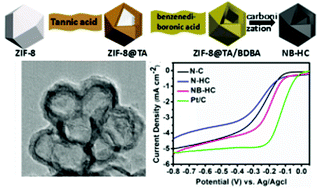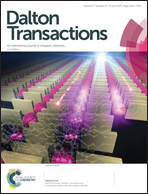Tannic acid-mediated synthesis of dual-heteroatom-doped hollow carbon from a metal–organic framework for efficient oxygen reduction reaction†
Abstract
Herein, we report an original strategy to fabricate N/B co-doped hollow carbon (denoted as NB–HC) with the assistance of tannic acid. Inspired by its inherent porous structures, we used ZIF-8 as a structural template and a N-doping source. Tannic acid (TA) as a secondary material is uniformly coated on the surface of ZIF-8 to obtain ZIF-8@TA core–shell composites. The TA-modified shell mediates the post-formation of boron acid-polyol bond, where 1,4-benzene diboronic acid (BDBA) is used as a boron-containing reactant and doping source. After carbonization, the composite successfully turns into hollow N/B co-doped carbon with a high surface area of 936 m2 g−1. It exhibits a pronounced ORR reactivity with an onset potential of −0.12 V (vs. Ag/AgCl) along with superb methanol cross-over tolerance and long-term stability. The first-principles calculation proves that the synergistic effect arising from N and B dopants can create active sites; therefore, the value of free energy change in the rate-determining step decreases. This elucidates that the homogeneously synergistic coupling of B and N in the carbon structure and hierarchical porous structures endow the as-prepared NB–HC with enhanced ORR parameters.



 Please wait while we load your content...
Please wait while we load your content...